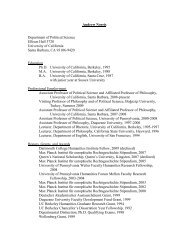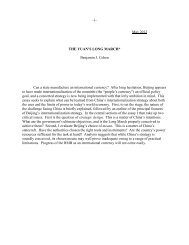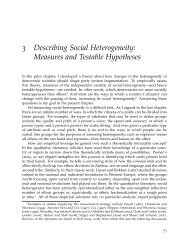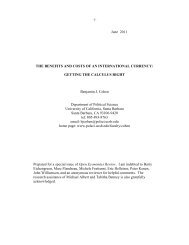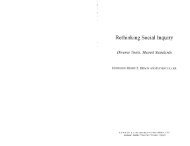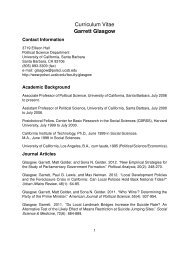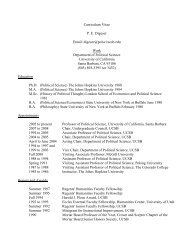Are Niche Parties Fundamentally Different from Mainstream Parties ...
Are Niche Parties Fundamentally Different from Mainstream Parties ...
Are Niche Parties Fundamentally Different from Mainstream Parties ...
You also want an ePaper? Increase the reach of your titles
YUMPU automatically turns print PDFs into web optimized ePapers that Google loves.
ARE NICHE PARTIES DIFFERENT? 521<br />
policy shift variable) denotes the shift in the party’s policy<br />
position between the current election and the previous<br />
election away <strong>from</strong> the center of the voter distribution and<br />
is coded as the absolute value of the change in a party’s<br />
policy position when a left-wing party shifted to the left or<br />
when a right-wing party shifted to the right, and zero otherwise.<br />
NP J is the niche party dummy variable described<br />
in equation (1). Interacting this dummy variable with the<br />
centrist policy shift and noncentrist policy shift variables<br />
allows us to examine differences in the electoral effects of<br />
both centrist and noncentrist policy shifts for niche and<br />
mainstream parties.<br />
As with the model we specified to test the Costly Policy<br />
Shift Hypothesis, our use of interaction terms with<br />
dummy variables leads to a relatively straightforward interpretation<br />
of this model. First, consider the electoral<br />
effect of policy shifts by a mainstream party. The dummy<br />
variable for niche parties, NP J , will equal zero in this case,<br />
and thus the electoral effect of centrist and noncentrist<br />
policy shifts on a mainstream party’s vote share will be<br />
captured solely by the coefficients on the centrist policy<br />
shift and noncentrist policy shift variables (coefficients B 1<br />
and B 2 in equation 2). We expect mainstream parties to<br />
gain vote share when they shift their policies in a moderate<br />
direction and to lose vote share when they shift their<br />
policies in a noncentrist direction.<br />
Next consider the electoral effect of policy shifts by<br />
niche parties. The dummy variable NP J equals one in this<br />
case, and thus the influence of centrist policy shifts on the<br />
vote share of niche parties will be captured by the sum of<br />
the coefficients on centrist policy shift and centrist policy<br />
shift × niche party (B 1 + B 4 ). Similarly, the influence of<br />
extremist policy shifts on the vote share of niche parties<br />
will be captured by the sum of the coefficients on noncentrist<br />
policy shift and noncentrist policy shift × niche party<br />
(B 2 + B 5 ).<br />
The Costly Policy Shift Hypothesis (H 2 ) posits that<br />
in comparison to mainstream parties, niche parties are<br />
penalized electorally for shifting their policy programs,<br />
regardless of the direction of the policy shift. In terms<br />
of our model, the Costly Policy Shift Hypothesis makes<br />
two predictions. The first is that (B 1 + B 4 ) < B 1 ,or<br />
B 4 < 0—i.e., that niche parties are penalized electorally<br />
CMP and Eurobarometer 10-point scales are directly comparable<br />
(for instance, assuming that a 4.1 on one scale is to the right of<br />
4.0 on the other scale). Note that this coding strategy assumes that<br />
the mean voter position in each country is invariably located to<br />
the right of all members of the party system that were classified<br />
as left-wing in our analysis, and to the left of all parties classified<br />
as right-wing. A comparison of the Eurobarometer respondents’<br />
Left-Right self-placements with their Left-Right placements of the<br />
parties, which were obtained in the 1989 Eurobarometer survey<br />
(Survey 31A), supports this assumption.<br />
for moderating policy shifts in comparison to mainstream<br />
parties. The second is that (B 2 + B 5 ) < B 2 ,orB 5 < 0—i.e.,<br />
that niche parties are penalized electorally for noncentrist<br />
policy shifts in comparison to mainstream parties.<br />
Thus, if our estimates of the coefficients B 4 and B 5 are<br />
both negative and statistically significant, this will indicate<br />
that niche parties suffer an electoral penalty relative to<br />
mainstream parties when shifting their policy positions,<br />
regardless of the direction of the policy shift, providing<br />
evidence in favor of the Costly Policy Shift Hypothesis.<br />
Conversely, if either B 4 or B 5 is not statistically significant<br />
(or if either estimate is positive and statistically significant),<br />
we cannot reject the null hypothesis, that niche<br />
parties do not suffer an electoral penalty relative to mainstream<br />
parties for any type of policy shift.<br />
The Costly Policy Moderation Hypothesis (H 3 )isa<br />
component of the Costly Policy Shift Hypothesis (H 2 ) and<br />
posits that in comparison to mainstream parties, niche<br />
parties are penalized electorally for moderating their policy<br />
programs. Regardless of our estimate of B 5 , if our estimate<br />
of B 4 is negative and statistically significant, this will<br />
imply that niche parties suffer an electoral penalty relative<br />
to mainstream parties when moderating their policy<br />
positions, providing evidence in favor of the Costly Policy<br />
Moderation Hypothesis. Conversely, if B 4 is not statistically<br />
significant (or if it is positive and statistically significant),<br />
we cannot reject the null hypothesis, that niche<br />
parties do not suffer an electoral penalty relative to mainstream<br />
parties when moderating their policy positions.<br />
In addition to the variables described in our core specification,<br />
we include several variables to control for other<br />
factors that previous researchers have identified as influencing<br />
party support independently of the parties’ policy<br />
shifts. The first is constructed with a view to capturing<br />
electoral effects associated with shifts in voters’ policy<br />
preferences. This variable, which we labeled public opinion<br />
shift, captures the direction and magnitude of shifts in the<br />
mean voter Left-Right position between the previous and<br />
the current election. This public opinion shift variable<br />
takes on a positive value when public opinion shifts in the<br />
direction of the party’s policy positions (i.e., the variable is<br />
positive for right-wing parties when public opinion shifts<br />
to the right, and for left-wing parties when public opinion<br />
shifts to the left) and a negative value when public opinion<br />
shifts away <strong>from</strong> the party’s policies. 11 Previous empirical<br />
work (Erikson, MacKuen, and Stimson 2002; Ezrow 2005;<br />
McDonald and Budge 2005) finds that parties’ electoral<br />
fortunes are affected by such public opinion shifts, so that<br />
11 Our procedure for classifying parties as leftist, centrist, or rightwing<br />
is described in footnote 10.




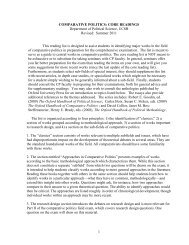
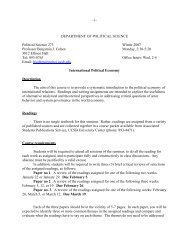

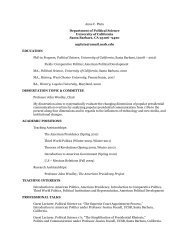
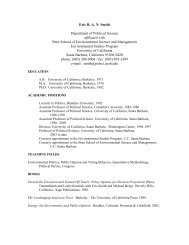
![Curriculum Vitae [abbreviated] John T. Woolley Professor of Political ...](https://img.yumpu.com/25423597/1/190x245/curriculum-vitae-abbreviated-john-t-woolley-professor-of-political-.jpg?quality=85)
